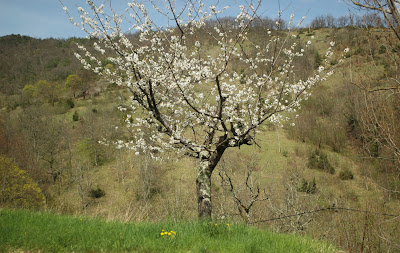In an article of 2 July 2012 entitled
Not the answer [
display], I deplored my inability to prevent mysterious Gamone rodents from devouring the totality of my walnut harvest. The culprits are almost certainly
dormice (plural of
dormouse,
loir in French), seen here in a photo that I found on the web.
Otherwise, they might be members of the
marten family (
martre and
fouine in French). I've often discovered the aftermath of their operations, but I've only had fleeting images of the animals themselves, who operate during the night. Well, at the end of the above-mentioned blog post, I vowed that I was determined to acquire some kind of anti-rodent walnut container. I searched at length on the Internet, but could find nothing of a suitable nature. Finally, I had to use my imagination in designing and building the ideal container, which I've just completed.
It's a meter wide, 50 cm in depth and 50 cm in height. The container is based upon a sturdy welded frame of angular steel. Stainless steel wire netting, sufficiently fine to keep out mice, is held in place by bolted strips of wood. The base of thick plywood is posed upon sturdy metal roller wheels. Theoretically, once it's closed by means of its heavy plywood lid, the fauna of Gamone should not be capable of accessing walnuts placed inside this container.
Instead of simply piling my current stock of Gamone walnuts into the new wire-mesh container, I decided to distribute them into several independent white-plastic crates, which will enable air to circulate more freely around the fruit.
Late yesterday afternoon, I went out shopping for these crates... at a moment when most shoppers were buying foodstuffs for their New Year dinners. (To be truthful, I dashed into the supermarket for a box of two dozen excellent Brittany oysters. At this time of the year, I'm reminded inevitably of arriving in St-Brieuc, once upon a time, and helping
Jacques Mafart in the ritual opening of dozens of oysters.) No sooner had I stepped into a first self-service hardware store than I found exactly the ideal model of blue plastic crates that I had imagined. Using my tape measure, I was thrilled to discover that four of these big sturdy crates would occupy exactly the space inside my wire-mesh container: 100 cm x 50 cm x 50 cm. Alas, when I reached the pay desk, dragging along my four plastic crates, the young female employee smiled at me and explained:
"I'm sorry, sir, but those are new containers that we received this afternoon, to be used by customers to hold their purchases inside the store. But we don't sell such crates." I asked her politely if I might be able to steal these crates.
"You're free to try, sir," she replied with a friendly smile, "as long as we don't catch you." I decided that it would be easier to look elsewhere.
In case you were wondering, let me confirm that the construction of this container has necessitated a lot of time and energy. My Gamone walnuts are precious. So, if the anti-rodent container fulfills its purpose, I won't consider that my work has been "overkill". Meanwhile, I might add that the walnut box was built in the midst of my ongoing work site aimed at constructing a carport. Here's a photo of the current state of this project, which is evolving slowly but surely:
Inside the house, I'm pursuing my erection of a chimney system for a cast-iron wood stove, as outlined in my recent blog post entitled
Fitzroy's favorite positions [
display]. In all my life, I don't think I've ever been more active at a practical do-it-yourself construction level. The underlying reason for my hyperactivity is my firm belief that I shall remain at Gamone for the rest of my life on the planet Earth. In a nutshell, it's unthinkable that I could come upon a better environment in which to meditate upon existence.
The determined gaze of
Fitzroy, in his favorite position at the top of the staircase, provides me with a model for meditation about crucial questions, and thinking about the future.

In normal circumstances, I hardly need to insist to persuade my dog to cuddle up against me in one way or another. The ultimate situation is when he finds me seated in front of the fireplace, and scrambles up into my lap. But curiously, when Fitzroy happens to be seated in his favorite position at the top of the staircase, it's difficult to distract his attention in any way whatsoever. His eyes are fixed intently upon an imaginary horizon, as if he were awaiting instructions from the heavens. Only after a minute or so does he appear to break out of his top-of-the-staircase spell, and scramble down the stairs. It's as if he were emerging from a moment of meditation, of verity. As for me, I like to imagine myself at the top of the staircase, and I seek inspiration from Fitzroy. My dog is my god.
AFTERTHOUGHT: I'm wondering whether Fitzroy's fixed regard at the top of the staircase might be an archaic genetically-acquired behavior associated with the obvious folly of a wolf turning its head when it happened to be seated on the brink of a precipice, observing what's happening down in the valley. Wolves who turned around to communicate with accompanying animals would have been likely to topple off into the abyss. Only the eyes-straight-ahead animals would have survived. I can think of no other explanation. Besides, I've noticed that Fitzroy is fond of squatting on the brink of embankments at Gamone, and gazing straight ahead of himself while waiting for something to happen.


















































